Look busy, the Boss is coming: Bruce Springsteen at JPJ
A Boss glossary: Or how to smarm your way backstage
39 1/2 Institute Street: The address in Freehold, New Jersey where Adele and Douglas Springsteen raise their son Bruce and his younger sister, Ginny, until 1962 and site of the birth of Pamela Springsteen. If you want to embellish with a little extra detail, study the photo of Bruce in the cover art of the single "My Hometown." He's standing right next to it.
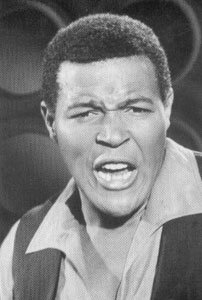
Chubby Checker
COURTESY OF CHUBBY CHECKER
Chubby Checker: The headliner of the first concert Springsteen ever attended, a matinee show at the Steel Pier in Atlantic City on June 29, 1962. Don't ask him to do the twist with you after the show, though. He'll probably be all danced out by that point.
Kent: The manufacturer of Springsteen's first electic guitar, which he received as a Christmas gift in 1964 after he was inspired by watching the Beatles and Rolling Stones make their American television debuts earlier that year. Mother Adele purchased the guitar for $60. No cracks about it being "Born in the U.S.A.," though. Kents were manufactured in Korea and Japan.
The Castiles: Springsteen's first band formed in 1965, when he was only 15. You could name-drop any of his bandmates– Frank Marziotti, George Theiss, Paul Pokin, or Bart Haynes– or the site of their first gig, a private party at the home of Tex and Marion Vinyard in Springsteen's hometown of Freehold.
St. Rose of Lima: The Catholic school Bruce attended in Freehold. Don't make the mistake of mentioning a diploma, though. After butting heads with the nuns, he transferred to Freehold High, where he did graduate, but he didn't attend his commencement ceremony.
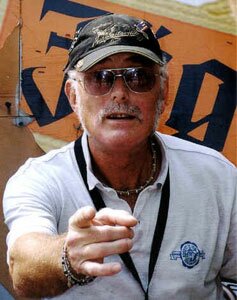
Vini "Mad Dog" Lopez wants you!
COURTESY OF STEEL MILL RETRO
Vini Lopez: The original E Street Band drummer long before Max Weinberg. He also played in previous Springsteen-fronted outfit Steel Mill along with current E-Streeters Little Steven Van Zandt, and Richmond's Robbin Thompson (see following story for more), and the late Danny Federici, a band that frequently played Richmond nightspots like Hullabaloo, the String Factory, and the Back Door in the early '70s. Refer to Lopez by his nickname "Mad Dog" for extra authenticity.
Mrs. Jay's Beer Garden: Even casual Springsteen fans know that one of Bruce's favorite places to play is the Asbury Park, New Jersey club known as the Stone Pony. However, if you can pepper your conversations about the legendary club with mentions of this biker bar that once stood two doors down, you may get past security yet.
Monroe Park: The park in Richmond's Fan District that was the venue for Springsteen's first-ever show in the Commonwealth on June 1, 1969, when Springsteen was a long-haired 19-year-old guitarist for the band Child.
Cole Field House: The University of Maryland basketball arena where a 23-year-old Springsteen and his band served as the opening act and then the backing group for Chuck Berry on April 28, 1973. To bone up on the details of the show, review Springsteen's recollection of the event in the Berry concert documentary Hail! Hail! Rock 'n Roll!
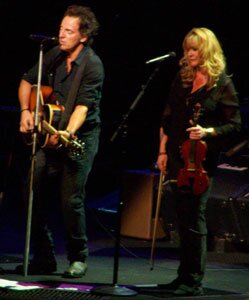
Fiddler Soozie Tyrell sharing the spotlight in Milan with the Boss in November of last year.
COURTESY OF LUIGI BAGATELLA VIA FLICKR
Soozie & High in the Saddle: They're the country band once fronted by current E Street fiddler Soozie Tyrell. They didn't have much competition for the best country band in their area in the '70s, as they used to play much of the same Lower Manhattan territory that was birthing such punk pioneers the Ramones, the Dead Boys, and the Patti Smith Group.
Miami Steve: The original nickname for E Street band guitarist Little Steven Van Zandt. Before he wore bandanas and baggy shirts, Van Zandt's onstage attire was a white suit with a matching fedora to go along with his tropical moniker. He would get dressed to the nines again years later when he portrayed mobster Silvio Dante on HBO's The Sopranos.
Big Man: The popular nickname for E Street saxophonist, native Virginian, and frequent Springsteen onstage foil Clarence Clemons, as in the song "Tenth Avenue Freeze Out," "Well the change was made uptown, and the Big Man joined the band." Calling out to Clemons by his nickname in your best raspy Bruce impression might just catch his eye as he breezes past security.
Jon Landau: As a critic for Boston's The Real Paper, he wrote in 1974, "I have seen the future of rock and roll, and its name is Bruce Springsteen." He also saw his own future in the Boss, as he quit writing reviews to become Springsteen's manager, a job he retains to this day. This is probably for the best, too, as he once gave the Rolling Stones' Sticky Fingers album zero stars, wrote off Eric Clapton as a "master of blues clichés," and predicted Bob Dylan's album Blood on the Tracks would "only sound like a great album for a while."
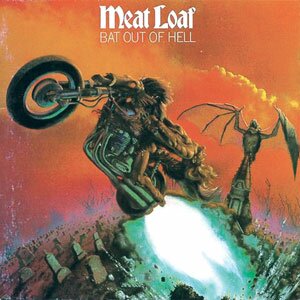
A few of Bruce's boys took a vacation from E Street to help make Meat Loaf a star with this album.
ALBUM COVER
Bat out of Hell: Both E Street Band pianist Roy Bittan and drummer Max Weinberg moonlighted as session players on this career-defining album by Meat Loaf. Be careful not to make the same mistake as NBC Tomorrow host Tom Snyder and refer to the bombastic singer as "Meatball."
Grin: Early '70s country rock band fronted by eventual E Street Band guitarist Nils Lofgren. On March 18, 1972, the then-unsigned Bruce Springsteen Band opened for Lofgren and company at Hampden-Sydney College near Farmville.
Ronald Reagan: In 1984, Springsteen most definitely did not endorse the Gipper's re-election bid when Reagan began using his "Born in the U.S.A." in campaign rallies and dropping Bruce's name in a speech in New Jersey. Springsteen responded by dedicating his "Johnny 99" to Reagan– a song about a laid-off worker who goes on a shooting spree. Any talk of "Born in the U.S.A." being a jingoistic anthem won't get you anywhere near E Street.
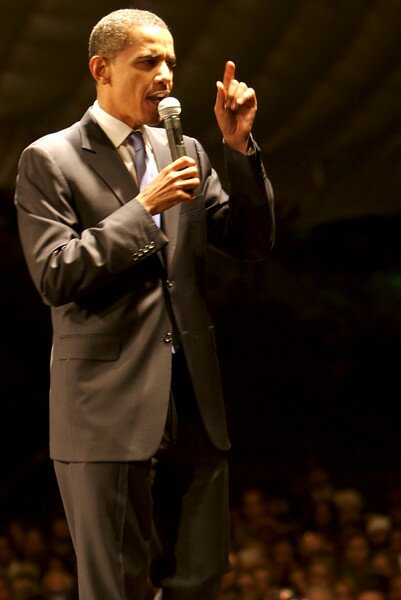
It turns out we've been mishearing the last lyric of "Blinded by the Light" all these years. Bruce is really singing, "Obama, that's where the fun is."
FILE PHOTO BY TOM DALY
Barack Obama: Just this month, Bruce announced that he's backing the senator from Illinois in his bid for the presidency. In a message on his website, the Boss wrote that Obama, "He speaks to the America I've envisioned in my music for the past 35 years, a generous nation with a citizenry willing to tackle nuanced and complex problems, a country that's interested in its collective destiny and in the potential of its gathered spirit. A place where 'nobody crowds you, and nobody goes it alone,'" quoting his own song "Long Walk Home." Sporting an "Obama for America" sticker couldn't hurt.
Brendan O'Brien: In some ways, he's the newest member of the E Street Band. After hearing his work in such bands as Pearl Jam, Stone Temple Pilots, and Rage Against The Machine, Springsteen enlisted O'Brien's help to produce his 2002 Grammy-winning album The Rising– the first new producer with whom the E Street Band had worked in 18 years. So satisfied was Springsteen with the results he kept O'Brien on for last year's Magic.
Soledad O'Brien: CNN anchor with whom Springsteen isn't as chummy. In a 2006 interview, when she asked the Boss how he felt about people who believed musicians shouldn't preach politics, he said, "If you tune in to– present company included– the idiots rambling along on cable television any night of the week, and you say that musicians shouldn't speak up? It's insane."
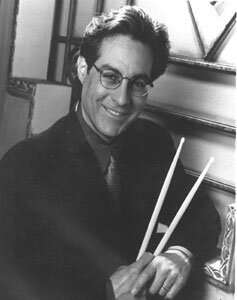
Despite the natty dressing, Max Weinberg is not an attorney at law.
PUBLICITY PHOTO
Yeshiva University Cardozo School of Law: Where E Street Band drummer Max Weinberg went to law school after Springsteen disbanded the E Street Band in 1989. Don't bother him with your legal queries, however. Weinberg did not finish his first year, and by 1993 he found work as the bandleader for a new talk show: Late Night with Conan O'Brien.
Sun City: If you happened to visit this South African resort sometime in the '80s, keep it to yourself. Steven Van Zandt had a Top-40 hit with a protest song about boycotting the popular hotel which paid artists like Rod Stewart, Queen, Cher, and Linda Ronstadt to perform to all-white audiences in apartheid-era South Africa. Don't mention it in the presence of Pat Benatar, George Clinton, Lou Reed, Jackson Browne, Bonnie Raitt, Bob Dylan, Bono, or the Boss himself, as they all leant their voices to the song.
Roman: Not to be outdone by Steven Van Zandt's turn on The Sopranos, Clarence Clemons landed his own role on an HBO series, portraying this youth program organizer on the Baltimore crime drama The Wire in 2004. He also had a recurring part portraying "Big Barry" on the CBS cop show Nash Bridges.
Cinnamon raisin bagels: According to a contract obtained by TheSmokingGun.com, Springsteen requires four of them be in his dressing room upon arrival along with an assortment of teas, a fruit basket, and "raw oats." Maybe a Bodo's run is in order?
Before the Boss: Robbin Thompson shared the spotlight
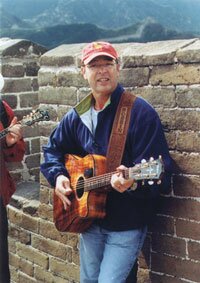
Robbin Thompson has since toured the world with his music, including this 2001 trip to the Great Wall of China.
COURTESY OF ROBBIN THOMPSON
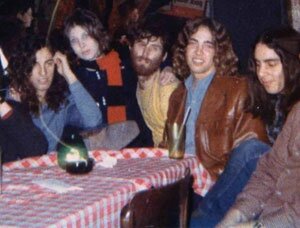
Steel Mill hangs out at the Green Mermaid in Asbury Park, New Jersey in 1971. Springsteen is on the far left, Thompson is second from the right, and future E Street Band guitarist Steve Van Zandt is on the far right.
COURTESY OF ROBBIN THOMPSON
When young Robbin Thompson first arrived in Richmond in the fall of 1969, it was ostensibly to bone up on book learning as a student at Virginia Commonwealth University. However, it was plain to anyone who talked to Thompson about what he'd done just before he got there that he was there for an entirely different kind of education.
"I had been in bands all through high school, I'd already had a few singles that I'd written out when I was 17, and I'd just come from Woodstock right before I got to VCU," he says. "So I wanted to be in a band."
Given his songwriting acumen, plus the fact that he owned his own PA system, it took mere weeks for Thompson to find a spot in progressive rock group Mercy Flight. At around the same time, he caught a show at a VCU-area club called the Center by a band he has never forgotten.
"They were called Child, they did their own stuff, and they had this great frontman and guitar player," he says. "He was animated, and he had a look about him, this intangible magnetism, and an honesty about what he did."
That was Thompson's first impression of 19-year-old, long-haired Bruce Springsteen. Over the next year, the bespectacled Floridian and the wiry New Jerseyan became well acquainted as Child changed its name to Steel Mill, and practically made Richmond its second home, frequently sharing the bill with Mercy Child for concerts around the VCU and University of Richmond campuses.
"We became good friends pretty quickly," says Thompson of Springsteen. "They were the same age as us, and he would always crash at my apartment. I'd do the same when we played up there, so we got to know each other for that whole year."
The culmination of all those gigs in tiny clubs like Hullabaloo and the String Factory came on August 14, 1970, when Steel Mill and Mercy Child teamed for a show that still looms large in Richmond lore.
"We rented all the spaces on the top level of the Marshall Street parking garage and put on a concert for free," says Thompson. "Several thousand people showed up for it."
After seeing the response Thompson got from such a large audience, Springsteen approached him with a proposition.
"He told me they were thinking of adding another person, and asked if I'd like to come to New Jersey with him for a weekend, and see how it went with me singing with Steel Mill," he recalls. "My first thought was 'why?' but I didn't dare ask that out loud. So I went up, and the next thing I know, I'm in the band."
So, putting his studies on hold, Thompson moved to the small Jersey Shore town of Wanamassa and took up residence with Springsteen, bassist Steve Van Zandt, keyboard player Danny Federici, and drummer Vini Lopez in the Challenger Eastern Surfboard factory.
"Being from Florida, I was a surfer, so this was exciting for me, because I thought I might get a free board out of the deal," says Thompson. "Bruce surfed, too, but most people in New Jersey sucked at surfing, and he wasn't very good."
That wasn't the only cultural difference Thompson noticed between himself and Springsteen.
"I had lived for the day I could go get my driver's license when I was a teenager," says Thompson, "but Bruce still hadn't gotten his. I couldn't believe it. He was like, 'Yeah, maybe I'll go get it next week.' So we took him out for a few practice runs. He wasn't bad, and he finally got his license when he was 21."
After just a couple weeks' rehearsal, the new Steel Mill lineup was ready to make its debut at Clearwater Swim Club in nearby Atlantic Highlands. But it turned out, not everyone at the show was a fan of their brand of rock 'n roll.
"There were police lined up behind the stage ready to cut the power at whatever time the curfew was," says Thompson, "but when they did, our manager unscrewed a light bulb and jerry rigged it so the power came back on and we could keep playing. Then the police decided they'd get up onstage and try to stop the music that way, but one of the cops tried to use one of our amplifiers for leverage to climb up, and it fell on another one. That started a riot. The band got out unscathed, but people out there were getting billy clubbed. It was like a film clip out of the '60s."
Thompson and company managed to avoid such melees in future gigs, crisscrossing the East Coast, both headlining and opening for the likes of Roy Orbison, Black Sabbath, and the Ike & Tina Turner Revue at a homecoming show at Richmond's Mosque (now the Landmark Theater). While Springsteen is known as a larger-than-life frontman now, Thompson says the man who would be Boss was happy to share the spotlight with him.
"There wasn't really any structure of who would do what," Thompson says. "Bruce was the leader of the band without question, but if I had written a song I thought was good, he'd let me sing it, and sometimes he'd write a song and ask me to sing it because he thought I'd sound better on it."
But as Thompson had suspected when he first saw him in Richmond, Springsteen would not be sharing the spotlight with anyone for long. In December 1970, Springsteen disbanded Steel Mill.
"I always knew that if anyone was going to get signed, it wasn't going to be Steel Mill, it was going to be Bruce Springsteen," says Thompson. "For me, nothing but good came out of that moment. It gave me the confidence to know I could write and sing with the best."
Fellow Steel Millers Van Zandt, Federici, and Lopez went on to form the core of the Bruce Springsteen Band, soon to be known the world over as the E Street Band. Thompson did not achieve the same heights, but has been a successful singer-songwriter in his own right, earning a Billboard Top 100 hit with "Brite Eyes," and endearing himself to Virginians everywhere with what has become the unofficial state anthem, "Sweet Virginia Breeze."
Through it all, Springsteen and Thompson have remained friends, and when the Boss had a date at the Richmond Coliseum on March 6, 2003, he made sure his former bandmate was backstage for the show. But as Thompson soon discovered, it wasn't just to reminisce.
"One of his people came up to me and said, 'If you hear 'Thunder Road,' head below the stage,'" he recalls. "So after the song he walks beneath the stage, Bruce Hornsby's there with his accordion, and he says we're all going to do the Hank Ballard song 'Let's Go, Let's Go, Let's Go,' in A."
There was just one problem.
Thompson says, "I had never even heard of the song."
Still, he figured he was still safe from embarrassment in front of thousands of fans as long as he strummed along to the right chords.
"Then Bruce comes up to me during the song and says, 'I'm going to take a verse, then Hornsby, then you.'"
Not having a clue about the words, Thompson proceeded to do as Springsteen had taught him to do in the days of Steel Mill– improvise.
"I made up some words that rhymed and made sure to include something about Richmond," he says. "Everyone went crazy, and I looked over, and there was Bruce laughing his ass off."
Thompson says that while he will be in attendance for the show at John Paul Jones Arena, he hasn't a clue if he'll be asked to do an encore.
"If Bruce asks me," says Thompson, "I guess I'll just have to be ready to figure it out as I go."
Bruce-V-A: When Springsteen rocked Mem Gym
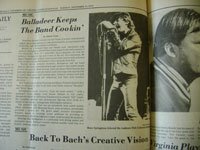
Before Born to Run ever hit record stores, Bruce Springsteen played for a half-full Memorial Gym on November 17, 1974.
PHOTO BY LINDSAY BARNES
Before the days of selling out stadiums and arenas in mere minutes, Bruce Springsteen was just another rock 'n roll dreamer making stops up and down the East Coast, playing his songs for anyone who'd listen. And by 1974, with hundreds of shows under his belt, he knew his narrative lyrics and amplified sound resonated most with college crowds.
So, sandwiched between dates at American University in Washington, D.C. and Camden County College in Blackwood, New Jersey, Springsteen and the E Street Band rolled into UVA's Memorial Gym on the night of November 17, 1974– almost a full year before he pulled off the rare feat of gracing the covers of both Newsweek and Time in the same week.
"Some of my friends and I were anxious to see what this guy was about," says Jim Fama, who had been assigned to review the show for the Cavalier Daily. "It was at a time when there were a lot of British bands, a lot of psychedelic bands, a lot of California jam bands like the Grateful Dead, but nothing like the kind of urban storytelling, R&B sound he was doing."
Fama wasn't the only curious Cav. Roughly 1,000 people plunked down $3.50 to see the show at Mem Gym, filling about half the venue. And as Fama soon discovered, Springsteen was not the biggest name in the building.
"I'm in the back, and I'm looking around, and over to my left there's [future Eagles guitarist] Joe Walsh, who was in the James Gang at the time," says Fama. "Well, I loved the James Gang, so I walked over and asked what he was doing there. And he put his finger up to his lips like 'Don't tell anybody I'm here,' and he says, 'I wanted to check this guy out.'"
It didn't take long for Fama, Walsh, and the others in attendance to get caught up in Springsteen's frenzied performance.
"At first, everyone was sitting on the floor," says Fama. "But Bruce got to dancing, and doing his routine with Clarence Clemons, drenching himself in sweat, and he really got everybody else to get up and jump around as much as he was."
Fama doesn't recall the details of the setlist, but his Cavalier Daily review cites "Rosalita (Come Out Tonight)" and "Kitty's Back" both from that year's release, The Wild, the Innocent, and the E Street Shuffle. He concluded his critique with these prophetic words:
"Showing that Springsteen is a performer with strong appeal and undeniable talent, Sunday's concert marked another small step in a steadily climbing musical career."
Brush with Bruce: When Springsteen joined with local legends
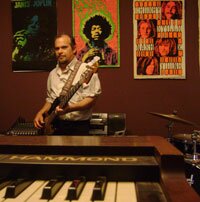
Steve Riggs played bass for the Allstars, the Charlottesville blues outfit Rolling Stone once dubbed "the best blues band in the Southeast."
PHOTO BY LINDSAY BARNES
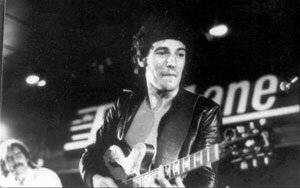
Being without his trademark Fender Telecaster, Springsteen had to borrow this Gibson for the impromptu performance with the Allstars.
COURTESY OF DOUG JAY
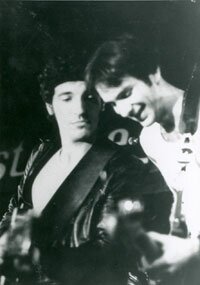
Guitarist Dick Green follows along with Springsteen during their spur-of-the-moment performance of Chuck Berry's "Oh, Carol."
COURTESY OF DICK GREEN
Before there was Sparky's Flaw or Dave Matthews Band or even the Skip Castro Band, the first Charlottesville band to gain national attention was a scrappy blues ensemble known simply as the Allstars.
After years of playing seemingly every juke joint and dive bar on the East Coast, they landed a deal with Adelphi Records in 1978 for nationwide distribution of their first album, Tip Your Waitress. By the fall of that year, the hard-driving quintet had drawn the attention of Rolling Stone, who raved of the debut LP, "This leaves no doubt that this crew is just about the best blues band in the southeast."
Evidently the magazine's editors weren't the only ones to get the tip about Tip Your Waitress.
Four months later, in April 1979, the band took the stage at the Fast Lane, a club in Asbury Park, New Jersey. Little did they guess that the town's most famous resident would be in attendance.
"Someone noticed Bruce at the bar, in the dark, drinking some orange liqueur alone," recalls harmonica player Doug Jay.
"We'd worked with a few different musicians from the area, but I'd never met Bruce Springsteen," recalls Allstars bassist Steve Riggs. "I'd never even seen a concert of his."
Guitarist Dick Green was even less a fan.
"I held him in some contempt," Green says, "not having listened to his music enough to get it, and resenting his popularity, contrasted with my own relative obscurity."
During a break between sets, and before the resentful Green could protest, he found himself led over to the bar by a Jersey-based friend who introduced him to Springsteen.
"Somebody must have helped him into his jeans because they laced up in the back," Green recalls, "but he seemed like a nice guy, and I said if he wanted to sit in, just walk up to the stage."
Little did Green know that Springsteen would take him up on his offer, with a little friendly goading from those in attendance.
"By the time we finished, the crowd had detected him and began the 'Bruce, Bruce' chant," he says. "I was walking over to thank him for coming, and as I approached, he took my offered hand, pulled himself out of his seat and said, 'Let's do this.'"
"He didn't have a guitar, so he had to borrow our guitarist, Steve Bliley's, cherry red Gibson," says bassist Riggs. "So he gets up there and starts playing the Chuck Berry song 'Oh, Carol.'"
It didn't take long for Riggs to be won over.
"I was mesmerized," he says. "We had already played with a lot of big names like Muddy Waters, Jimmie Vaughan, B.B. King. This guy was the most engaging showman of them all, and an incredible guitar player. He just created so much energy on that stage."
Or, as Jay puts it, "Needless to say, the crowd went nuts."
Still, Green had yet to be convinced.
"I had assumed that, like Elvis, he wore the guitar but couldn't much play it," says Green. "So when the time came around for solos, I decided to cut him a new one."
To Green's surprise, he had sorely misjudged the superstar.
"We kept trading bars, and I kept playing faster, more tasteless, stuff, and he'd smile and kick them right back at me," says Green. "Then I sank to the lowest plane of guitar playing and started playing behind my head. He looked perplexed. I knew I had him. Except then he hauled that big Gibson up over his head and joined me, note for note, until the blood ran out of our arms, and we had to give up."
After the show, Springsteen hung around to give the band his regards, and then disappeared into the New Jersey darkness as quickly as he had emerged, never to be seen in person by any of the Allstars again.
While the Allstars' fame never achieved E-Street heights, each of the band members has continued to play in blues and R&B outfits the world over, with Jay fronting Doug Jay and the Blue Jays while based in Germany, and Riggs laying down the bass for such local groups as the Olivarez Trio and the Chickenhead Blues Band.
Soon, the Allstars will return to it glory days (to to borrow a Springsteen title) when the Tip Your Waitress-era lineup reunites June 6 for Fridays After 5 at the Charlottesville Pavilion.
#